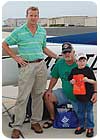
An IP-based video surveillance system was specified for a campus of buildings at Crevier BMW, Santa Ana, Calif., the largest BMW dealership in the United States, at the suggestion of the dealership’s IT manager and because it was substantially less expensive in cabling and installation costs.
“When I came to the dealership in January of 2005, they had already gotten five or six different competitive bids on traditional coaxial analog camera systems,†relates Howard Holton, Crevier’s IT manager. “Being the new head IT person, I said, ‘Let’s take a look at this IP technology. It has been around a while, and that will lower our infrastructure costs and give us better management.’
“So we just basically turned around and asked the companies that had given us bids to rebid against themselves in an IP versus traditional analog-based system,†he recalls.
Janelli Kelsey was working for one of the companies that bid on the job. “We ran two scenarios, one analog because it was quoted previously and he wasn’t happy with what he received,†reports Kelsey, who is now an outside sales account executive at southern California distributor Walters Wholesale, Signal Hill, Calif.
“When we ran the comparison, not just for the first phase but the whole project from start to finish, there was about a 60 percent difference in costs to the end user,†she explains. “Since it’s a campus environment, networking the video saved tons in cabling costs. With an analog system, it would have been fiber, trenching, all the fun stuff we don’t like to do if we don’t have to.

A total of 16 PTZ dome cameras are installed outdoors as part of the first phase of an IP-based video surveillance system at Crevier BMW, Santa Ana, Calif.
Adds Holton, “The IP system is a significant saving over the traditional analog design, especially when you’re looking at DVRs. The cost for the camera hardware is a little bit higher, but the NVR server can handle up to 64 cameras without a problem, so that’s really where we saw the big cost savings.â€
As a result of Crevier’s lack of employees dedicated to security, Holton had that responsibility added to his duties, which already included telecommunications, IT networking and facilities management. With IT as his primary responsibility, it was only natural that Holton would consider an IP-based solution.
“We were able to run everything into our main data facility and have one punch down there,†Holton says. “We were able to use our standard Cat 5e cable rather than running a new set of coax cable. The only thing we had to do was to create a separate network for much of the video system.
“Our main network is 100 MB per second and the video was using up, or trying to take up, about 70 percent of that,†Holton relates. “Now it’s down to about 30 percent.
“One of the nice things about the cameras we chose is we’re able to pick on a camera-by-camera basis what size video we’d like to get from the cameras,†he explains. “The system uses MPEG4 compression, which only records frame changes, so if you have a reasonably static picture, you have very little data being recorded and transmitted. It reduces the network utilization on the camera system.â€

One of two indoor PTZ dome cameras keeps a watchful eye on the BMW showroom. The dealership sells approximately 5,000 to 6,000 vehicles per year.
Because the installation was on an existing network, an integrator with data and security experience, Data Installers, Chino, Calif., was selected for the job.
“We did the installation of all the cameras and the running of the cable and conduit for all three buildings,†relates Edgar Estevez, Data Installers’ co-owner. “It took us a week – four guys, 10 hours a day to finish the installation.â€
That bane of security installers – voltage drop over longer cable runs – figured in this installation. “We did have a problem with the distance of the Cat 5e for power,†Estevez concedes. “Around 200 feet, it started failing, so we had to run bigger gauge cable for the power for the cameras. We went to 16-gauge, and that worked a lot better.
“What it was doing was the PTZ would work, but when it started moving and it was over 250 feet, it would turn off, and they would reboot and start all over again,†Estevez explains. “It took us a little while to troubleshoot all that.â€
Holton agrees. “What we found was if the length got around 200 feet, because 18- or 20-gauge wire is in Cat 5e, it would lose so much amperage it wouldn’t power the PTZ,†he states. Running extra power was not necessary for closer distances, he notes.

A PTZ dome camera from Infinova Networks, Monmouth Junction, N.J., is used in the service entry area to check for any damage to cars and determine where it occurred.
The cameras are able to capture numeric information from an identifier tag that hangs from the rear view mirror of each vehicle. All of the cameras are recorded into the network video recorder through Infinova’s video management NVR software.
The information then can be recalled by any authorized user on his or her PC. Holton identifies the cost-effectiveness of this approach as yet another factor that motivated him to select an IP solution.
Established in 1971, Crevier sells approximately 5,000 to 6,000 vehicles per year, including Mini Coopers, a BMW-owned brand. Before the new surveillance system was installed, the dealer’s security system consisted of three “old fixed cameras†that were not doing much of anything, according to Holton.
The new system covers each of four facilities that comprise the dealership. A total of 16 PTZ domes are installed in the main facility, which house administrative offices, new car sales and the service department. Additional cameras are located at a facility devoted to the Mini Coopers and another building considered a remote service facility.
Eight stationary cameras are traditional analog ones and are run through an analog to digital converter. “We didn’t need the PC capability because we have so few of them, and there’s also a size advantage to the analog cameras because there’s no PTZ,†Holton points out. “They’re very small; you can put your hand over the whole dome. They’re less obtrusive; you probably wouldn’t know they were there.â€
The system will be expanded to cover a fourth building that just had been completed at press time. The six-story building, which will house a large parking garage and the resale department, will add about two dozen IP cameras to the system.
After several months of operation, Holton is pleased with the IP-based system and looks forward to working with the company and Walters Wholesale on the next phase of the project.
Sidebar: On the Job
- From Infinova Networks, Monmouth Junction, N.J. (www.infinova.net)
- 16 PTZ IP dome cameras outside
- 2 PTZ IP dome cameras inside
- 8 stationary analog cameras
- Model V2215 network video recorder
Sidebar: projects in the news
- Magal Security Systems Ltd., Yahud, Israel, received an order of approximately $5.5 million from the Israeli Ministry of Defense (MOD) for installation of a perimeter intrusion detection system along the northern border of Israel. Most of the work will be done before the end of 2006, with the balance to be completed by the end of the first quarter of 2007.
- North American Video (NAV), Brick, N.J., completed a video surveillance and security system for the recently reopened Beau Rivage Resort and Casino, Biloxi, Miss. The contract for the video surveillance and security system covered restoration of the new casino after Hurricane Katrina, and the hotel, garage and surrounding property. The new video surveillance and security system includes more than 1,200 video surveillance cameras integrated to an enterprise NVR solution along with a two new matrix switching systems. NAV also has furnished and installed all alarms on the grounds, an audio playback messaging system and a new emergency call station system for the parking garage. Also new to the system is a state-of-the-art point of sale interface to the CCTV system.
- The Greater Laguna FireSafe Council in the San Diego area is deploying IPELA SNC-RZ25N video surveillance cameras from Sony Electronics, Park Ridge, N.J., linked by wireless networks, to help catch, contain and extinguish flare-ups before they become wildfires. Since its creation in the mid-1990s, the council’s Red Flag members patrol the Laguna Beach region in cars marked with magnetic signs and window flags. In 2003, David Mitchell, president of PRO 911 Systems, suggested extending and enhancing the lookouts’ capabilities with the surveillance cameras. His company helped create high-speed wireless Internet access across Laguna Beach by creating a Tropos MetroMesh wireless network. Now those dispatched can access the critical video and operate the cameras with wireless-connected laptops and hand-held computers.

Sidebar: projects in the news
Dome Cameras Donated for Medical FlightsCancer patient Jesse Heaton with his father Jesse Sr. and Gale Tynefield, chief executive of Angel Flight South Central who is on the pilots’ roster, board a medical flight. Angel Flight South Central helps patients who do not have access to conventional transport or who are too ill to be driven or fly on a commercial service. Private pilots volunteer their planes and time to take people from their local airstrip to hospitals and clinics in other cities, often combining in relays so that a journey of thousands of miles can be made. Working through its partner ADI, Rainbow has donated six HDCVF3D vandal-proof dome camera units for use in hangars at Houston Hobby Airport and a new 1,500-square-foot facility, where patients wait in privacy for transportation and their pilots study routes in a planning room.





